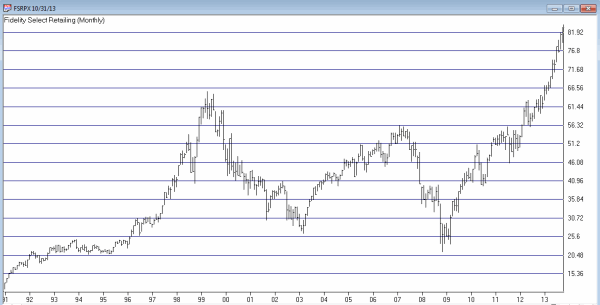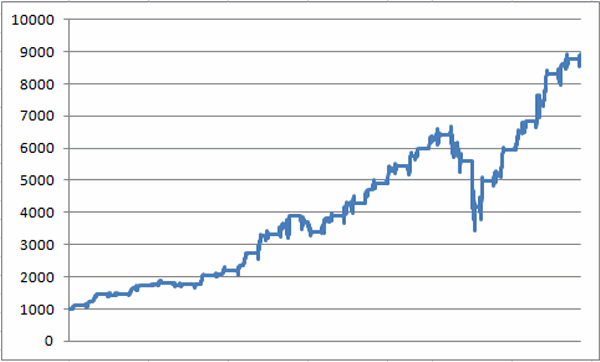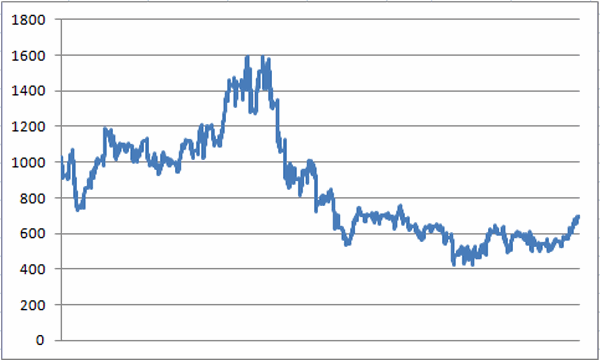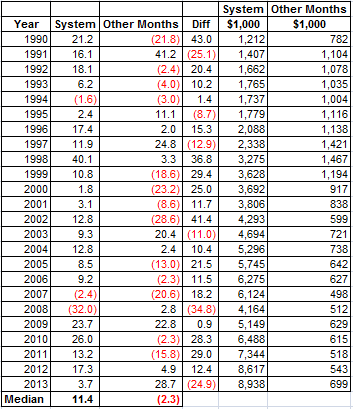Oct 30, 2013 | options, trading strategies, volatility
They say that complacency is the enemy of the stock market. If so, the action of ticker VXX – the exchange-traded fund designed to track the VIX Index – may be of interest.
The indicator known as “Narrow Range 7”, or NR7 for short was first introduced by Toby Crabel some time back in the 1980’s or 1990’s. The theory is that when the difference between today’s high price and low price for a given security is the smallest it’s been over the past 7 trading days, that security is said to be “contracting” or “compressing.” The theory goes that – just as ying follows yang – once the compression is over there should be an “expansion”, – i.e., a meaningful price movement.
Now this is not always necessarily the case – i.e., a security can remain mired in a range for a good long while. In addition, a simple NR7 gives no indication on its own as to whether the ensuing price expansion will be to the upside or to the downside. Still, please note the chart in Figure 1. This extreme compression DOES NOT guarantee or even imply that the stock market is about to decline. But it sure does seem to signal a whole lot of complacency among investors.
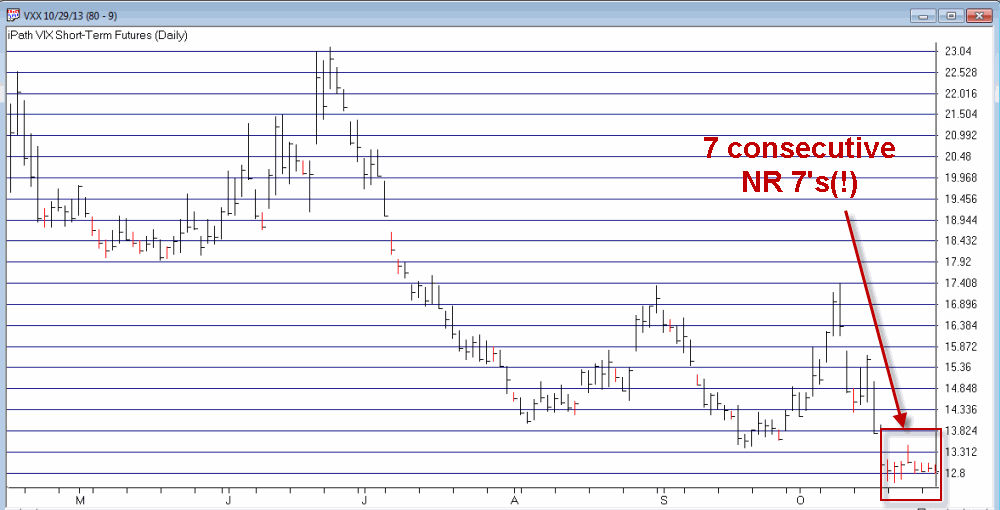
Figure 1 – Ticker VXX has registered seven consecutive days of narrower and narrower ranges (Courtesy: AIQ TradingExpert)
In all candor I am not entirely sure what this means. My gut tells me that following the whole “shutdown/debt limit” crisis, and with QE2IB (Quantitative Easing to Infinity and Beyond) set to feed liquidity to the market until the end of time, it is pretty much assumed that the stock market has nowhere to go but higher.
Complicating this for me personally is that most of my indicators are bullish, so I am not inclined to pound the table and shout “the end is near!” (although it is kind of fun to see the looks on people’s faces when I do it just for fun.)
Still, it is not a stretch to think that we could be setting up for a nasty surprise in the near-term (i.e., sometime in the next several weeks) which would certainly surprise the heck out of most investors. People who are inclined to hedge might consider buying VXX December 13 strike price call options (as I write, it is $99 for a 1-lot, with the futures suggesting that stock indexes will open higher, i.e., that VXX will open lower).

Figure 2 – VXX December 13 call (Courtesy: ww.OptionsAnalysis.com)
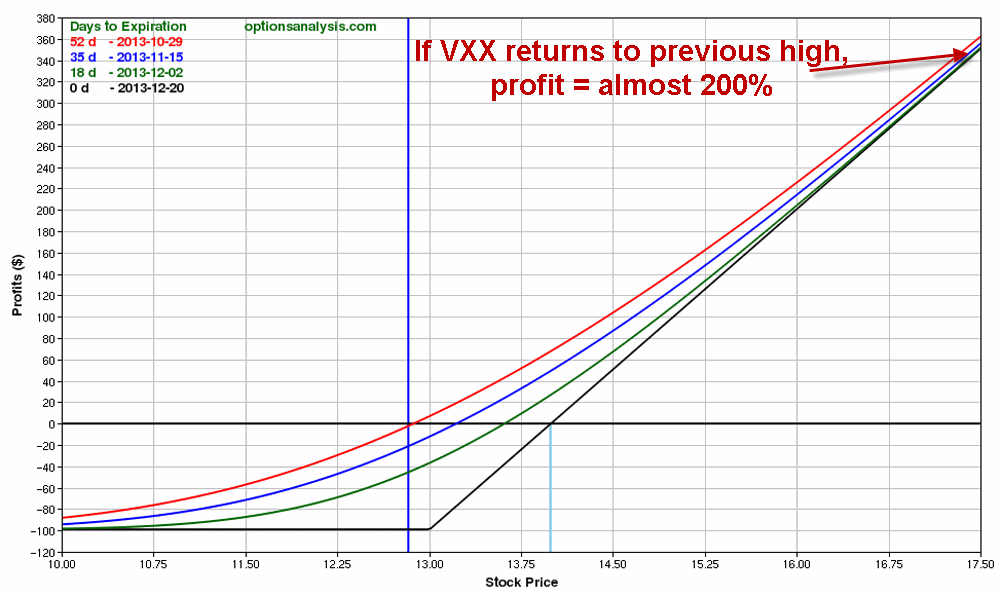
Figure 3 – VXX December 13 Call (Courtesy: ww.OptionsAnalysis.com)
Summary
Everything – trend-following, seasonal, liquidity – seems to point to a bullish trend in the stock market. And I am not one to stand in the way. But historically when everything “looks good” for the stock market, one of two things happens: Either the stock market:
a) trends higher based on the bullish confluence of indicators, or,
b) the market surprises the daylights out of the majority with a nasty surprise.
$99 to insure against b seems like a reasonable price to pay.
Jay Kaeppel
Chief Market Analyst at JayOnTheMarkets.com and AIQ TradingExpert Pro (http://aiq.com) client
Jay has published four books on futures, option and stock trading. He was Head Trader for a CTA from 1995 through 2003. As a computer programmer, he co-developed trading software that was voted “Best Option Trading System” six consecutive years by readers of Technical Analysis of Stocks and Commodities magazine. A featured speaker and instructor at live and on-line trading seminars, he has authored over 30 articles in Technical Analysis of Stocks and Commodities magazine, Active Trader magazine, Futures & Options magazine and on-line at www.Investopedia.com.
Oct 25, 2013 | retail stocks, Seasonality, trading strategies
I am a fan of “simple” strategies. For the record, yes, I have multiplied the standard deviation of the regression line times the implied volatility of the 90+ day options in order to, in order to, um, well, I seem to recall that there was a really important reason why I did it at the time. Or so it seemed. Still, I am reminded of:
Jay’s Trading Maxim #316: When it comes to analyzing markets and indicators, multiplying (or dividing) two numbers just “because you can”, is not necessarily helpful.
So again, I generally try to keep things simple. Which is great, because the idea in this piece is something I first discovered in the 1990’s, and “trading systems” (such as it is, in this case) don’t get much simpler. So here goes.
When to Own Retailing Stocks
The “system” I discovered in the 1990’s for retailing stocks works like this:
-Buy and hold retailing stocks during the months of February, March, October and November.
That’s it.
As with most things in life there is some good news and some bad news. Let’s start with the bad news. Like a lot of things, this “system” got crushed during the 2008 meltdown, suffering a -48% drawdown.
For those of you who are about to stop reading because of that last figure, just let me say DO NOT STOP READING!
The good news is that despite being fully invested in retailing stocks during the worst meltdown in modern history, the system has since soared to much higher new highs and has outperformed a buy and hold approach by 40% (+791% for the system vs. +562% for buy and hold) since December 1989.
What this means in a nutshell is that if you held retailing stocks only during all eight of the other months every year since 1990, you would actually have lost about -26%. This dichotomy of performance would not seem evident from a cursory glance at Figure 1.
Figure 1 – FSRPX Monthly Bar Chart (Courtesy AIQ TradingExpert)
Figure 2 displays the growth of $1,000 invested in Fidelity Select Retailing fund (ticker FRSPX) only during the months of February, March, October and November, starting in December 1989.
Figure 2 – Growth of $1,000 invested in FSRPX during “bullish” four months (since December 1989)
Again, the good news and bad news is fairly obvious. For the most part the system was a model of equity growth consistency – OK, except of course for the 2007-2008 “Express Elevator to Hell” period. Still, it is instructive to consider what would have happened had you simply skipped these four month every year and invested in retailing stocks only during all of the other eight months of the year. These results appear in Figure 3.
Figure 3 – Growth of $1,000 invested in FSRPX during all other months (since December 1989)
Figure 4 displays the performance of FSRPX during the four “favorable” months (i.e., the “system”) versus the performance of FSRPX during all other months (i.e., the “Anti System”) on an annual basis. The results are fairly striking
Figure 4 – Systems results versus “Anti System” Results
Figure 5 – Systems results versus “Anti System” Results
A few things to note:
-The System has showed a gain 21 out of 24 years.
-The Anti System showed a gain in only 11 years.
-The System outperformed the Anti System 75% of the time.
-The System showed a net gain of +794%.
-The Anti System showed a net loss of -30%.
Summary
Obviously during some years retailing stocks will rally outside of our four “favorable” months (for example, this year). But the long-term results suggest that investors would do well to focus on retailing stocks during February, March, October and November.
A Note for Option Traders
One less expensive way to make this play is to buy a deep-in-the-money call option on ticker XRT (SPDR Retail ETF). Here is an example:
-On 9/30/2013 a trader could have purchased 400 shares of XRT at $82.01 a share. The cost of this trade would be $32,804. The net delta of this position is 400.
-An option trader could have bought 5 December XRT 76 call option at $6.90. The cost of this trade would be $3,450. This option has a delta of 81.29, so buying 5 contracts yields a net delta of 401.26. In other words, this position will behave just like the stock position, but at a fraction of the cost ($3,450 versus $32,804).
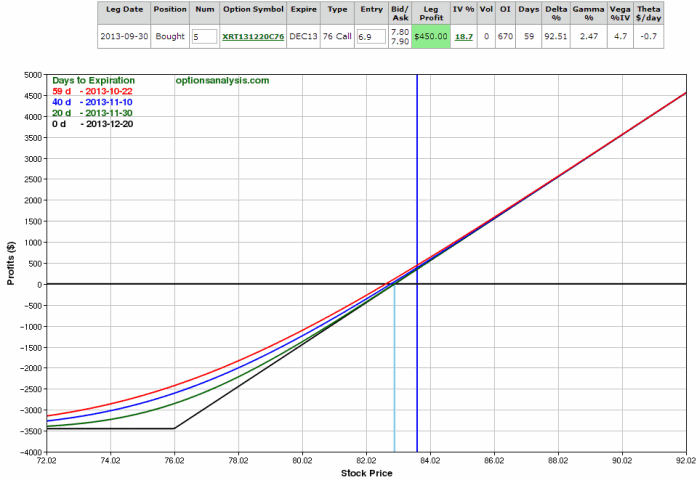 Figure 6 –XRT December 76 call option as a replacement for stock shares (Courtesy: www.OptionsAnalysis.com)
Figure 6 –XRT December 76 call option as a replacement for stock shares (Courtesy: www.OptionsAnalysis.com)
As this is written:
-400 XRT shares are up 2% on an investment of $32,804 since 9/30.
-5 XRT December 76 calls options are up 13% on an investment of $3,450 since 9/30.
Jay Kaeppel
Chief Market Analyst at JayOnTheMarkets.com and AIQ TradingExpert Pro (http://aiq.com) client
Jay has published four books on futures, option and stock trading. He was Head Trader for a CTA from 1995 through 2003. As a computer programmer, he co-developed trading software that was voted “Best Option Trading System” six consecutive years by readers of Technical Analysis of Stocks and Commodities magazine. A featured speaker and instructor at live and on-line trading seminars, he has authored over 30 articles in Technical Analysis of Stocks and Commodities magazine, Active Trader magazine, Futures & Options magazine and on-line at www.Investopedia.com.
Oct 21, 2013 | ETFs, group sector rotation, Seasonality, sector funds, trading strategies
The Stock Trader’s Almanac, put out each year by the Hirsch Organization, is one of my favorite publications. Interesting ideas are one thing. Interesting ideas that actually work are entirely something else. And the Almanac is chock full of just that.
Of course, some of us are not content to leave well enough alone (Hi, my name is Jay). One system that I follow involves using the Almanac’s “Nasdaq’s Best Eight Months Strategy” with MACD Timing. However, instead of buying a stock index I focus on the top performing Fidelity Select Sector Funds.
The method works like this:
-Starting on October first, track the action of the MACD indicator for the Nasdaq Composite Index using MACD parameter values of 8/17/9.
-When the fast line crosses above the slow line – or if the fast line is already above the slow line on 10/1, a buy signal occurs.
Figure 1 displays the most recent buy signal which occurred at the close on 10/15/13.
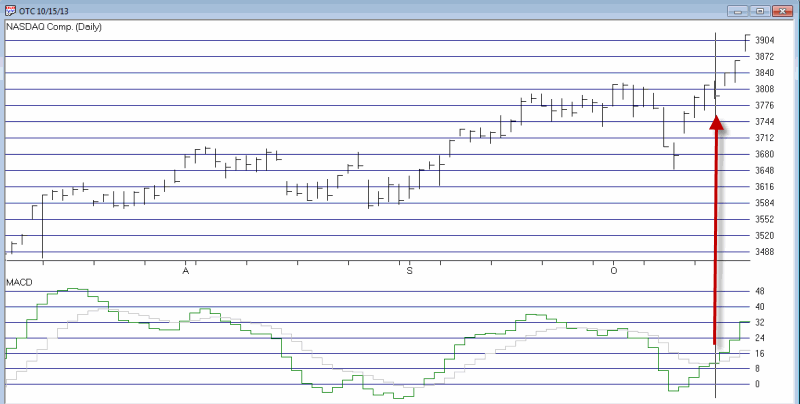
Figure 1 – MACD Buy Signal (Chart courtesy of AIQ TradingExpert)
-Then find the five top Fidelity Select sector funds.
There are a number of different ways to do this. The method I use is to run AIQ TradingExpert Relative Strength report over the past 240 trading days. This routine looks at the performance of each fund over 240 trading days but gives extra weight to the most recent 120 days. You can use different variables, or you can simply look at raw price change over the previous 6 months to come up with a list of “Top Select Sector Performers.” The list for 10/15/13 appears in Figure 2.
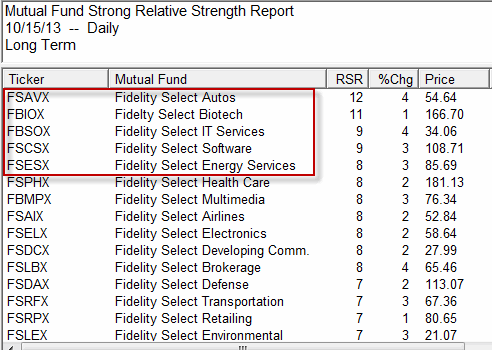
Figure 2 – High Relative Fidelity Select Sector Funds (Courtesy AIQ TradingExpert)
-Buy the top five Select Sector funds the next day.
-Starting on June 1st of the next year, track the action off the MACD indicator for the Nasdaq Composite Index using MACD parameter values of 12/25/9.
When the fast line crosses below the slow line – or if the fast line is already above the slow line on 6/1, then sell the Fidelity Select sector funds on the next trading day.
Repeat.
Results
The test period used here starts in October of 1998. The year-by-year results of this system during the Favorable eight month period versus the performance of the S&P 500 Index during the same time appears in Figure 3.
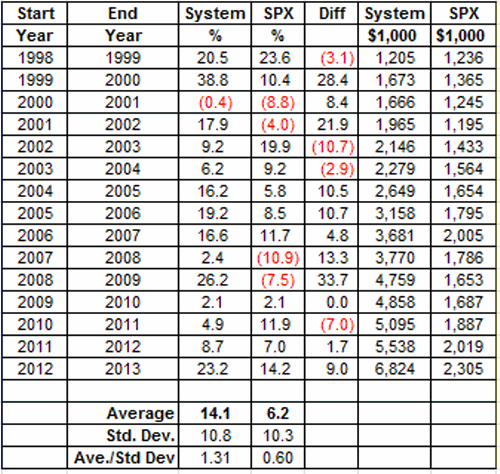
Figure 3 – Year-By-Year Bullish Eight Months (System vs. SPX)
|
Measure
|
System
|
S&P 500 Index
|
|
Number of times UP
|
14 (93%)
|
11 (73%)
|
|
Number Times Down
|
1(7%)
|
4 (27%)
|
|
Number time better performer
|
11
|
4
|
|
Average % +(-)
|
+14.1%
|
+6.2%
|
|
Worst %+(-)
|
(-0.8%)
|
(-10.9%)
|
Figure 4 – System versus S&P 500 during “Bullish Eight Months”
Summary
As you can see, this relatively simple system has registered a gain in 14 of the past 15 “bullish” eight month periods. On average it has outperformed the S&P 500 by a factor of 2.27-to-1.
So does any of this mean that a portfolio of FSAVX/FBIOX/FBSOX/FSCSX/FSESX is sure to make money and outperform the S&P 500 between now and June of 2014? Sadly, no.
I guess I’ll just have to take my chances.
Jay Kaeppel
Chief Market Analyst at JayOnTheMarkets.com and AIQ TradingExpert Pro client
http://jayonthemarkets.com/
Jay has published four books on futures, option and stock trading. He was Head Trader for a CTA from 1995 through 2003. As a computer programmer, he co-developed trading software that was voted “Best Option Trading System” six consecutive years by readers of Technical Analysis of Stocks and Commodities magazine. A featured speaker and instructor at live and on-line trading seminars, he has authored over 30 articles in Technical Analysis of Stocks and Commodities magazine, Active Trader magazine, Futures & Options magazine and on-line at www.Investopedia.com.
Apr 7, 2010 | ETFs, indicators, trading strategies
The market has been in a tight trading range for two weeks.
When the market is in a tight range most stocks do not move much
if they hit their trigger points so as noted in previous Letters,
tight ranges like this are best left alone. Trying to force trades
when the market is in a tight range will generally just churn the
account. These tight ranges do not last long, and are often followed
by nice tradable moves. When the market moves out of the range, I
will be actively trading in the direction of the break.
When the market is resting in a narrow trading range, instead of
swing trading I spend some time reviewing lessons I have learned
during the last twenty years. Some of the important ones are:
• There is no magic to trading. It is about putting the odds on
your side and not trading unless they are. This sounds simple,
but it takes a few years to get good at it. And like most things,
while you are learning it is best to work with someone. The
learning time is long because traders have to see how things
behave in different markets, and learn to trade the odds and
not their feelings. Read this paragraph again.
• The market will not adapt to us, we must adapt to it. Swing
trading in a trading range environment presents higher than
average risk. Traders can compensate for higher risk market
conditions by trading fewer positions and using smaller position
sizes. Failure to do this can be costly.
* Successful traders adjust their trading style, trading system,
holding Period, and exit strategies based on the current market
conditions. This is a process I refer to as market adaptive
trading. It is better to Learn how to adapt to the market rather
than running from one trading idea to the next looking for the
next super system. Being frustrated that the market is not doing
not what you want often leads to losses. The market does what
it wants, we just need to adapt to it. This will take time to learn,
be patient. Read this paragraph again.
* As a trader I do not care which way the market moves, I can
make money either way. It is important to be able to quickly
react to whatever the market does and not be emotionally
attached to any particular choice.
* I cannot control what the market does, so I have a plan for
whichever path it picks and then trade the plan.
* Successful trading is not about predicting what the market is
going to do. It is about knowing how to react to whatever it
actually does.
* Always be thinking about taking and protecting profits.
* If you are not sure what to do, exit the position. There will be
other good setups.
* You do not need to trade every day. Let the setups come to you
and take the best ones. When the market is moving there lots
of good setups to trade. If there are few setups, or most are
failing, then listen to the message of the market.
* Do not rush in, there is plenty of time to get into a
tradable move when the market changes. If a trend
is worth trading, then by definition you do not have
to be in on the first day.
* Never enter a position without a plan for exiting.
* Do not count your chickens before they hatch. You do not
have a profit until you are back in cash.
* Never trade with money you cannot afford to lose.
* Trading is not a team sport. Stay away from chat rooms and
financial TV. Seek the truth, not support from others with
your point of view.
Steve Palmquist a full time trader who invests his own money in the market every day. He has shared trading techniques and systems at seminars across the country; presented at the Traders Expo, and published articles in Stocks & Commodities, Traders-Journal, The Opening Bell, and Working Money. Steve is the author of, “Money-Making Candlestick Patterns, Backtested for Proven Results’, in which he shares backtesting research on popular candlestick patterns and shows what actually works, and what does not. Steve is the publisher of the, ‘Timely Trades Letter’ in which he shares his market analysis and specific trading setups for stocks and ETFs. To receive a sample of the ‘Timely Trades Letter’ send an email to sample@daisydogger.com. Steve’s website:www.daisydogger.com provides additional trading information and market adaptive trading techniques. Steve teaches a weekly web seminar on specific trading techniques and market analysis through Power Trader Tools.
Terms of Use & Disclaimer:
This newsletter is a publication for the education of short term stock traders. The newsletter is an educational and information service only, and not intended to offer investment advice. The information provided herein is not to be construed as an offer or recommendation to buy or sell stocks of any kind. The newsletter selections are not to be a recommendation to buy or sell any stock, but to aid the investor in making an informed decision based on technical analysis. Readers should always check with their licensed financial advisor and their tax advisor to determine the suitability of any investment or trade. Trading stocks involves risk and you may lose part or all of your investment. Do not trade with money you cannot afford to lose. All readers should consult their registered investment advisor concerning the risks inherent in the stock market prior to investing in or trading any securities.
Mar 22, 2010 | ETFs, indicators, Risk management, trading strategies
An Excerpt from the Timely Trades Letter.
Horizontal support and resistance levels should always be considered when selecting potential trades. Since stocks often consolidate, or bounce near support and resistance the distance between the entry point and support (for shorts) or resistance (for longs) is an important consideration when deciding whether or not to take a particular trade. I want to find trades with ‘room to run’ as the stock pulls back and approaches support.
Trading is based on being positioned to profit if the stock, or the market, does the usual thing in a given situation. Since stocks often bounce from support, candidates with a larger distance to support from the entry are more attractive because they have more ‘room to run. When a trading pattern occurs near support it may just drop to support and bounce, thereby limiting potential profits.
I also apply the same concepts of support, resistance, and accumulation to the market itself to determine if trading is appropriate. If I am trading shorts and the market is approaching support I become cautious. The reason is that the market often bounces or bases near support and thus shorts would be less attractive. When the market is clearly trending and well away from support I will use larger position sizes in my trades than when the market is approaching a support level. I cannot influence what the market does, but I can react to it and reduce my risks by taking smaller position sizes when the market is approaching a support level.
Someone usually asks the question, ‘yes, but what if the market had broken below support, would it not have been better to hold onto the short positions’?
I trade based on what the market usually does, not what I hope may
happen, or what sometimes happens. Since the market often bounces when retesting important lows I will stop taking new shorts and take profits on existing ones when the market approaches support. The market has two choices when it approaches support. It can bounce or it can break bellow. If the market bounces I will not incur potential losses from new shorts and will have the profits from the positions I closed. If the market breaks below support I will have the profits from the positions I closed and can easily take new positions to get back in the game. There is less risk in taking the profits when the market approaches support. It is tough to go broke taking profits. It is easy to go broke by holding on too long.
Things to do each evening:
Look at the price and volume action on the NASDAQ. Where are support and resistance levels? How is the volume on recent up and down days. Given the recent daily range, how many days would it take to reach support or resistance?
Look at each of your positions for the same information listed above. Where are your stops, and do they need to be adjusted? Do you have any stocks that are extended (consider profit taking) or ones that are breaking trend lines or support (consider exiting)?
Review your watch list of interesting patterns and make a list of the best set ups to take a look at tomorrow. Review the watch list for patterns that are no longer valid and delete those stocks from the
watch list.
Learning to trade with the Market is a key part of taking investment results to the next level. It’s harder than it sounds, and takes some experience. I haven’t met many traders who got the experience by paper trading, the pain of losing is what causes people to spend thetime and effort to review their trades and learn from the mistakes.Don’t just write off losses, learn from them, they are part of the tuition you pay to learn how to trade.
Learning to sell as the Market approaches resistance takes some practice, since after a nice run most people want to put more money in.
I generally place a protective stop immediately after entering the trade. The stop is normally under the previous day’s low, or the low of the pattern. Remember that the protective stop is just to keep you from having a bad loss. If you leave the stop at its initial protective value and use it as your only exit you will lose money. Generally set the initial protective stop at the point where the trade set up would be invalidated, then watch the behavior of the stock and the market to determine when to get out. I also make sure the stop is not at a round number, or something that ends in 5 since this is where most people place the stop. Instead of 23.00, I would place the stop at 22.95. Instead of 18.95, I would use 18.84.
Steve Palmquist a full time trader who invests his own
money in the market every day. He has shared trading
techniques and systems at seminars across the country;
presented at the Traders Expo, and published articles in
Stocks & Commodities, Traders-Journal, The Opening Bell,
and Working Money. Steve is the author of, “Money-Making Candlestick Patterns, Backtested for Proven Results’, in which he shares backtesting research on popular candlestick patterns and shows what actually works, and what does not. Steve is the publisher of the, ‘Timely Trades Letter’ in which he shares his market analysis and specific trading setups for stocks and ETFs. To receive a sample of the ‘Timely Trades Letter’ send an email to sample@daisydogger.com. Steve’s website:www.daisydogger.com provides additional trading information and market adaptive trading techniques. Steve teaches a weekly web seminar on specific trading techniques and market analysis through Power Trader Tools.
Terms of Use & Disclaimer:
This newsletter is a publication for the education of short
term stock traders. The newsletter is an educational and
information service only, and not intended to offer investment advice. The information provided herein is not to be construed as an offer or recommendation to buy or sell stocks of any kind. The newsletter selections are not to be a recommendation to buy or sell any stock, but to aid the investor in making an informed decision based on technical analysis. Readers should always check with their licensed financial advisor and their tax advisor to determine the suitability of any investment or trade. Trading stocks involves risk and you may lose part or all of your investment. Do not trade with money you cannot afford to lose. All readers should consult their registered investment advisor concerning the risks inherent in the stock market prior to
investing in or trading any securities.
Feb 4, 2010 | trading strategies
In bull markets everyone suddenly becomes an expert when their investments appreciate. What a marvelous turn of events. It is however that small segment of traders who have traded both sides of the divide using an informed trading procedure that will appreciate the irony of having the Midas touch.
The kind of protégés the bull market produces are deluded into believing in their rapidly acquired expertise, while engaging in the rampant growth investing demanded by Efficient Markets Theory. They are deprived of any opportunity to undertake any fundamental analysis to speak of, and a rarely called upon to exercise any discipline. Their clearly profitable trading process will most likely avoid review.
Security of property and resources is fundamental to Maslow’s Hierarchy of Needs, and in the pursuit of self interest, a human being will rarely find anything remotely attractive about a loss. Still, the inability to appreciate something ought not to be determinant of its existence, and a small loss will most definitely endure to be preferred over a large one.
Ultimately, no one participant is bigger than the market however, some individuals such as Warren Buffet standout with alarmingly consistent success. In response to how he became so wealthy A.J. Rockefeller merely replied ‘I guess I took my profits too soon’. The premise that traders such as these are simply lucky is ludicrous.
Integral to a trader’s systemic process is self realization. Unless traders can identify Maslow’s Hierarchy at work in themselves, they will be at continual risk of the inherent emotion that the Market feeds upon. For this reason, a non-reflective person will provide an easy target in the routine short covering rally, or the institutional sell-off that triggers all but the Governor’s stop loss order. Greed will cause such a person to watch a profitable position dissolve and crystallize into a loss; a traumatizing experience. Similarly, when looking into the abyss of capital loss, rather than finding character, such a person finds the fortitude to demand their preferred exit price. In the face of a disastrous inflation figure or even a war, this is the kind of stuff that nightmares are made off.
When a trader knows themselves, and caters for their idiosyncratic limitations within a considered trading process, they will find that taking responsibility for that process and the decisions therein, actually sets one free – free to trade again with undivided attention. When taking a loss, take it all at once, it only hurts for a little while.




